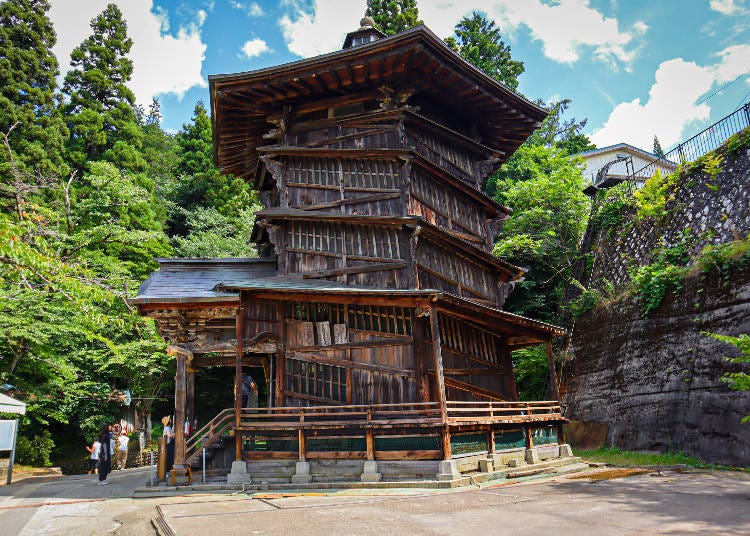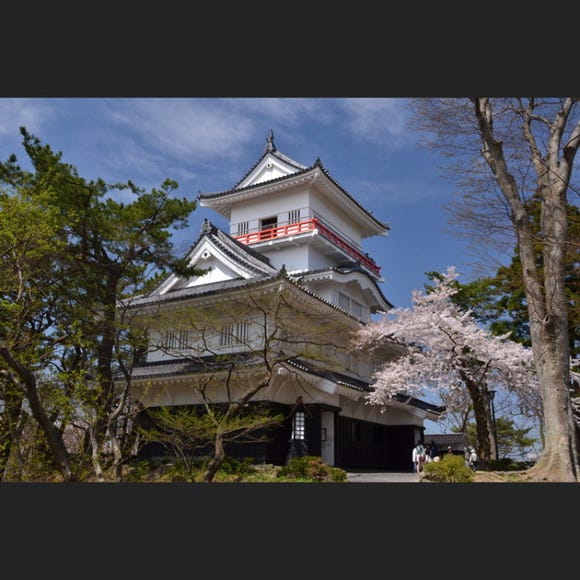
Exploring Tsuruga Castle (Tsurugajo): Aizu's Samurai Stronghold
- Written by: Alexander Litz
Amidst the scenic landscapes of Aizuwakamatsu in Fukushima Prefecture, Tsuruga Castle, also known as Aizuwakamatsu Castle, stands as a resolute guardian of Japan's feudal past. This historic stronghold, with its elegant black facade set against the backdrop of lush greenery, beckons visitors to embark on a journey through time. Beyond its formidable exterior lies a treasure trove of stories that unfold within the castle walls, narrating the exploits of samurai warriors and the resilience of a bygone era.
(Main image: Expedition Japan)
Why was Tsuruga Castle built? A brief history

The Aizu Basin has long been a source of life due to its rich and abundant natural resources. Blessed with fertile soil and thanks to its ample water resources, coupled with a well-balanced climate, it has allowed for the successful cultivation of crops, providing a stable and sustainable source of livelihood for centuries. Evidently, settlements dating back to ancient times flourished in this fertile expanse, eventually giving rise to a thriving castle town nestled in the southeastern corner of the basin.
Positioned in a geographically advantageous area, the Aizu area served as a crossroads for trade and transportation, and the basin's accessibility and connectivity to other regions made it a crucial hub, fostering economic activities and cultural exchanges, serving as the gateway to the north from Edo. With so much activity in the region, military fortification was needed, and in 1384, the groundwork for Tsuruga Castle was laid.
Before Tsuruga Castle, was Kurokawa Castle

During the Nanboku-cho period (1336-1392), the Ashina clan held sway over the region. In 1384, the 7th head of the Ashina clan, Ashina Naomori, erected Kurokawa Castle within the Aizu basin, laying the foundation for what would later become Tsuruga Castle. The Ashina clan proudly reigned over Kurokawa Castle for the next two centuries. However, as the chaos of the Sengoku period began to unfold, the influence of the Ashina clan began to dwindle, and neighboring enemies began to strike.
In 1589, Date Masamune, perhaps the most formidable and most famous warlord of the Tōhoku region during the Sengoku period, broke through the Date clan’s prolonged struggle against the Ashina clan and successfully seized the castle during the Siege of Kurokawa Castle. Nonetheless, Masamune was compelled to pledge allegiance to Toyotomi Hideyoshi in 1590, resulting in his relocation north to Sendai.
Aizu then fell under the governance of Hideyoshi’s general, Gamō Ujisato. Assigned to monitor Date Masamune closely, Ujisato undertook the transformation of Kurokawa Castle into a modern stronghold in 1592, renaming it Tsuruga Castle as we know and love it by today. Despite being alternately referred to as Aizu Castle or Wakamatsu Castle by the populace, the castle underwent further enhancement in 1593 with the construction of an unprecedentedly massive seven-story tenshu.
History of Tsuruga Castle

After only a few years, Ujisato succumbed to illness, prompting Toyotomi Hideyoshi to place the castle under the Uesugi clan’s Uesugi Kagekatsu, whom he relocated from Echigo Province (present-day Niigata) nearby. Following the Uesugi Clan’s allegiance with the Toyotomi clan during the Sekigahara campaign, the victorious Tokugawa clan entrusted the castle to the Katō clan, and under the Katō administration, the castle underwent reforms, imposing a new layout on the surrounding castle town.
However, a substantial earthquake in 1611 severely damaged the castle, leading to the reconstruction of the tenshu into its current configuration. In 1643, the Katō were dispossessed, making way for Hoshina Masayuki, the illegitimate son of Shōgun Tokugawa Hidetada and half-brother of Tokugawa Iemitsu. He later served as regent to the underage Shōgun Tokugawa Ietsuna, and under the new han system, Aizu-han, also known as the Aizu Domain, prospered. Throughout the Edo period (1603 – 1868), the Aizu Domain stood as a crucial Tokugawa stronghold in the Tōhoku region, showcasing the formidable military power of the Shōgunate, whose grasp was firm even in the north.
The Boshin War and the Byakkotai

The year 1868 marked the start of the fall of the Tokugawa shogunate, and by 1869, the lid of the coffin was sealed shut as the Boshin War ended with the restoration of imperial rule and victory for the South. The civil war was triggered by political and social changes, including discontent with the current Tokugawa government’s foreign influence and modernization efforts. As the movement to restore the emperor started and moved from the south, many of the Tokugawa’s most loyal supporters were in the north and had risen to power directly by supporting the Tokugawa in the past and were willing to lend their swords in battle.
The Aizu Domain, of course, sided with the Tokugawa and sent forth many of their most formidable troops into battle to rally to the cause. The Byakkotai “White Tiger Force,” however, was a group of 19 young samurai who served as a reserve unit in the Aizu domain’s military and were charged with staying home and protecting Aizu.
During the war, Aizu Wakamatsu Castle came under siege by imperial forces, and the Byakkotai, stationed on Iimori Hill, observed the castle engulfed in flames. Due to the wind direction and the intensity of the fire, they mistakenly believed that the castle had fallen to the enemy, and in a moment of despair, all 19 of the young boys decided to commit ritualistic suicide (seppuku) rather than face the shame of defeat.
However, the situation was not as dire as they thought, as Aizu Wakamatsu Castle had not fallen, and the flames they observed were from a temporary loss of control over part of the castle.
The tragic tale of the Byakkotai is well-known throughout Japan. Their unwavering loyalty and willingness to sacrifice themselves for their lord and domain became a symbol of samurai virtues and the tumultuous period of the Meiji Restoration. Today, the story is commemorated at Iimori Hill in Aizu Wakamatsu, where a monument stands in memory of the Byakkotai and their sacrifice.
-
Grave of Byakkotai "White Tiger Force"白虎隊士十九士の墓
- Address Takizawa-155 Itsukimachi Oaza Yahata, Aizuwakamatsu, Fukushima 965-0003
- Phone Number 0242-39-1251
・Open: 24 hours
・Price: Free
・Closed: None
Restoration of Tsuruga Castle Today

Post-Boshin War, the remaining castle structures, bearing scars from artillery fire during the siege and weakened structurally, were razed by the new government in 1874. Fortunately, one yagura managed to escape destruction by finding a new home at the Amida-ji Buddhist temple, located five kilometers from the original castle site. Subsequently, most of the castle grounds were sold to private landowners, leaving only the central portion under government ownership until 1908, serving as a base for the Imperial Japanese Army.
Inspired by the pre-war popularity of the Byakkotai story, a movement emerged to preserve the castle site picked up steam in the 1930s, leading to its transformation into a public park and eventually into the castle’s designation as a National Historic Site in 1934. In 1965, a concrete reconstruction of the tenshu, the castle’s main tower, was completed as the iconic centerpiece of the city, and today, the reconstructed castle houses a museum boasting panoramic views of the city.
-
Tsuruga Castle鶴ヶ城
- Address 1-1 Otemachi, Aizuwakamatsu, Fukushima 965-0873
- Phone Number 0242-27-4005
・Open: 8:30 AM - 5 PM
・Price: Adult 410 yen, Child 150 yen. (A combo ticket can also be purchased for 520 yen (460 yen for children) for both the castle and the tea room.)
・Closed: Open daily
Rinkaku Tea Room

In 1591, Sen no Rikyu, credited as the father of the Japanese tea ceremony, incurred the wrath of Toyotomi Hideyoshi, who ordered his death. Lamenting the loss of Rikyu’s tea ceremony, the lord of Aizu Castle at that time sheltered Rikyu’s son in Aizu, and together with Tokugawa Ieyasu, they sought the revival of the Sen family’s tea tradition. After appealing to Hideyoshi, they were granted permission to continue the Sen family’s tea legacy, and the Rinkaku Tea Room was constructed.
After the Boshin War, the Rinkaku Tea Room was relocated and preserved nearby in the castle town, and then in 1989, it was once more moved back to its original location within Tsuruga Castle.
Today, visitors can enjoy tea in the charming atmosphere of the historic tea room, and monthly tea ceremonies are held in honor of the Sen family.
-
Rinkaku Japanese Tea Room茶室 麟閣
- Address 1-1 Otemachi, Aizuwakamatsu, Fukushima 965-0873
- Phone Number 0242-27-4005
・Open: 8:30 AM - 5 PM
・Price: 210 yen Admission (A joint ticket with the castle can be purchased for 520 yen)
・Closed: Open daily
What else is there to do in Aizu Wakamatsu?

Aizu Wakamatsu has so much to offer and will wield unforgettable memories that will last a lifetime. If you check out our One Day Guide to Aizu Wakamatsu, you can learn all about the authentic samurai village, twisted temple, and all the best places to wash down local specialties with Aizu’s world-class sake!

Expedition Japan
Alexander Litz moved to rural Yamagata at age 15, and even after completing his studies across Seoul, Tokyo, and Taipei, he returned to Yamagata to share his love of northern Japan with the world as a freelance writer and translator. Having explored all 47 prefectures, Alexander transitioned to a career in tourism and now is the Director of Inbound Tourism at Expedition Japan, where beyond planning and leading unique trips in rural Japan, he does inbound consulting for local and regional governments as well as travel media to help show the world the charms of a Japan less traveled. He is a Nationally Licensed Tour Conductor, holds a Bachelor’s Degree in International Relations and Asian Studies from Temple University Japan, and is a Boren Scholar at National Taiwan University.
- Area
- Category
*Prices and options mentioned are subject to change.
*Unless stated otherwise, all prices include tax.
Popular Tours & Activitiess
Recommended places for you
-

Senshu Park
Parks
Surrounding Areas Of Akita
-

Nikka Whisky Sendai Distillery
Culture Experience
Sendai And Matsushima
-

Geibikei Gorge
Rivers, Lakes & Canyons
Morioka, Hiraizumi And Hachimantai
-

Sado Gold Mine
Winter
Niigata And Sado
-

Asamushi Onsen
Hot Springs (Onsen) & Bath Houses (Sento)
Aomori, Hirosaki And Hachinohe
-

Ginzan Onsen
Hot Springs (Onsen) & Bath Houses (Sento)
Surrounding Areas Of Yamagata
-

Shopping in Akita: 11 Must-Buy Souvenirs & Where to Shop Near the Station and Airport
by: ShiroKu inc.
-
Ad

Meet GU, UNIQLO’s Stylish Sister Brand! Fashion-Forward Clothing in the Latest Colors (Featuring Exclusive Coupon)
-

Smart Ways to Avoid Crowds and Enjoy a Safe, Comfortable Trip to Myoko, Niigata Prefecture.
-

Dining in Yamagata: Must-Try Foods & Top Restaurants Near the Station
by: ShiroKu inc.
-

Disney Meets Shinkansen: Two Themed Trains to Explore Japan's North and South in 2025
-

What to Buy in Aomori? 11 Aomori Souvenirs Locals Actually Recommend
by: ShiroKu inc.
-

Sendai Umino-Mori Aquarium: Inside Northeast Japan's Largest Aqua Attraction
-

Sumikawa Snow Park: Skiing in Northern Japan's Breathtaking Backcountry
-

Kaminoyama Onsen Guide: Best Things to Do in Japan's Samurai Town!
-

The Best of Japan: 11 Major Cities Every Traveler Should Visit
-

3 Famous Ramen Shops in Yamagata - Japan's "Ramen Prefecture"!
-

Healthcare in Japan for Tourists: What to Do When You Get Sick or Injured in Japan












